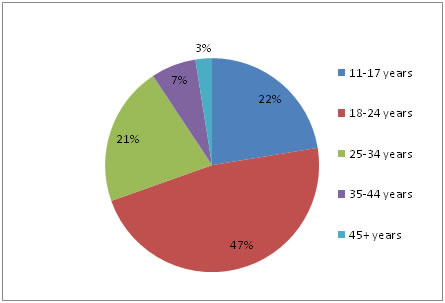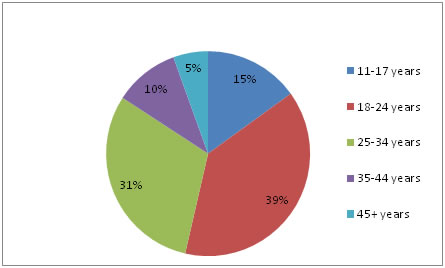Prevalence of Teen Dating Violence
The reported incidence of teen dating violence varies significantly across studies, yet even with variation the known prevalence rates establish it as a serious problem in the United States. The different rates of prevalence may be a result of differences in the methodology, the definitions, and/or in the targeted population used in the studies.1 Some definitions of teen dating violence include incidences of all three types of relationship violence (physical, sexual, and emotional or psychological violence), while others focus on just one or two of those types of violence. Further, youth may be afraid to disclose violence to friends and family. According to one study, only a third of teens who were in an abusive relationship ever told anyone about the abuse they experienced.2
The 2010 National Intimate Partner and Sexual Violence Survey (NISVS), a national survey of intimate partner violence and sexual violence, collected reports of lifetime intimate partner violence from a random sample of women and men 18 and older. Figure 1 shows the age that women first reported experiencing intimate partner violence, for those women who had reported sexual violence including rape, physical violence, psychological violence, or stalking in their lifetime. Of these women, 69.5 percent reported experiencing intimate partner violence for the first time under the age of 24.3
Figure 1. Age at First Experience of Intimate Partner Violence for Women

Note: Intimate Partner Violence includes any form of physical violence, sexual violence, stalking, psychological aggression, and control of reproductive or sexual health. Respondents represent only those who reported experiencing intimate partner violence in their lifetime.
Figure 2 provides a similar graph for men who reported experiencing intimate partner violence in their lifetime. The survey indicated that, of those men, more than half had their first experience prior to age 24.4
Figure 2. Age at First Experience of Intimate Partner Violence for Men

Note: Intimate partner violence includes any form of physical violence, sexual violence, stalking, psychological aggression, and control of reproductive or sexual health. Respondents represent only those who reported experiencing intimate partner violence in their lifetime.
(click “+” to see more details.)
- Rates of physical dating violence for youth have been found to range from 9 percent to 57 percent.5
- Nationally, according to the Youth Risk Behavior Surveillance System data, about ten percent of students report having been physically hurt by a boyfriend or girlfriend in the past 12 months.6 Across state-specific surveys the prevalence rates range from 7.4 percent to 17.8 percent with a median of 11.1 percent, and for local surveys the rates ranged from 8.0 percent to 18.5 percent with a median of 12.0 percent.7
- Figure 3 shows the increase in reported instances of physical and sexual partner violence from adolescence to young adulthood, as well as the persistence of violence for some youth.8
Figure 3. Percent of Responders Reporting Physical and Sexual Partner Violence Victimization in Three Waves of the National Longitudinal Study of Adolescent Health

- Rates of emotional and psychological abuse are far higher than physical violence for youth.9 Studies have found that as many as 76 percent of teens report emotional and psychological abuse during relationships.10
- According to analysis of the National Longitudinal Study of Adolescent Health, between 20 and 30 percent of youth reported being verbally or psychologically abused in the previous year. Specifically, 16 percent of youth age 12 to 21 have been insulted; 23 percent have been sworn at, and 4 percent have been threatened by a partner.11
- There is currently no nationally representative data on sexual dating violence specifically for youth. Smaller scale studies or studies focused on specific populations suggest that the rates of sexual violence tend to be lower than physical or psychological violence. Findings suggest that the prevalence of sexual violence ranges from 3 percent to 11 percent.12
- Recent research has found an overlap in reports of partner violence, pregnancy coercion, and birth control sabotage for young women. In addition they found links between these behaviors and unplanned pregnancies.13 Learn more about the relationship of gender and teen dating violence.
Resources
The National Intimate Partner and Sexual Violence Survey (NISVS)
The CDC’s National Intimate Partner and Sexual Violence Survey (NISVS) is an ongoing, nationally-representative telephone survey that collects detailed information on sexual violence, stalking, and intimate partner violence victimization of adult women and men in the United States. The survey collects data on past-year experiences of violence as well as lifetime experiences of violence. The survey is also supported by the National Institute of Justice and the Department of Defense. A full report (pdf, 124 pages), summary in English (pdf, 8 pages) and Spanish (pdf, 8 pages), fact sheet (pdf, 2 pages), toolkit (pdf, 56 pages), and state data tables are also available.
1 Offenhauer & Buchalter, 2011
2 Teenage Research Unlimited for Liz Claiborne Inc., 2005
3 Black et al., 2011
4 Black et al., 2011
5 O’Keefe, 2005
6 Centers for Disease Control and Prevention (CDC), 2010
7 CDC, 2010
8 Halpern, Spriggs, Martin, & Kupper, 2009
9 Offenhauer & Buchalter, 2011
10 Arriaga & Foshee, 2004
11 Halpern et al., 2001
12 Offenhauer & Buchalter, 2011
13 Miller et al., 2011
Youth Topics
Feature Articles
Tools & Guides
Technical Assistance
Websites
Videos & Podcasts
Hotlines
Agencies
Departments

- Characteristics of Healthy & Unhealthy Relationships
- Prevalence of Teen Dating Violence
- Electronic Aggression and Teen Dating Violence
- Teen Dating Violence and Gender
- Youth At Risk of Teen Dating Violence
- Preventing Teen Dating Violence
- Consequences of Teen Dating Violence
- Legal Responses to Teen Dating Violence
- Resources for Victims of Teen Dating Violence
- Public Awareness About Teen Dating Violence
- Additional Federal Resources
- References

Resources
Announcements
Youth Topics
Feature Articles

Map My Community is a tool designed specifically to assist you in locating resources in your community to help you build and strengthen your youth program. Get ideas for new partnerships, identify gaps in your community, and learn about resources to avoid duplication of effort.



















